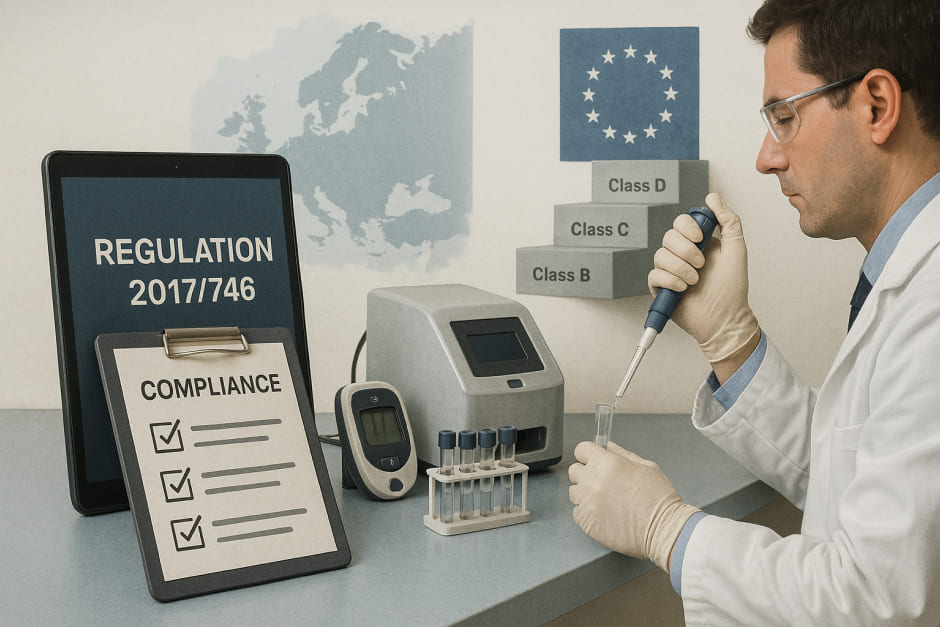The article describes in detail the approach to be followed in order to determine the regulatory status and applicable regulatory requirements.

Table of content
The Medical Device Coordination Group (MDCG), has published a guidance document dedicated to the classification rules for in vitro diagnostic medical devices (IVDs) under the new regulatory framework established under the Regulation (EU) 2017/746. The document provides additional clarifications and recommendations to be taken into consideration by medical device manufacturers and other parties involved in order to ensure compliance with the relevant regulatory requirements.
In particular, this guidance addresses the use of classification rules as laid out in Annex VIII of the Regulation, offering practical guidance for manufacturers, notified bodies, and health institutions. The guidance is also applicable to diagnostic or information society services performed on EU patients or via distance sales.
It has been developed by an expert group composed of representatives from Member State Competent Authorities, the European Commission, notified bodies, and industry, and takes into account corrigenda to the IVDR published in the Official Journal of the European Union. The purpose is to ensure uniform application of classification rules.
The document reminds stakeholders that classification decisions may be made through implementing acts by the European Commission upon request from a Member State or on its own initiative (Article 47 IVDR).
Definitions
First of all, the document provides definitions of the key terms and concepts used in the context of IVD classification including the following ones:
- Confirmatory device: Used to verify a positive result from an initial assay.
- First-line device: Used to detect a marker or analyte but not for ongoing monitoring.
- Detecting exposure: Indirect detection via surrogate markers like antibodies.
- Detecting presence: Direct identification of the agent or its components.
- Embryo or foetus: Unborn human from conception to birth.
- Offspring: Encompasses embryo, foetus, neonates, children, and adults.
- Infective/infectious agent: Any agent capable of causing infection.
- Life-threatening: Conditions generally untreatable.
- Devices for monitoring: Measure analyte levels for treatment adjustments.
- Devices for screening: Identify disease presence in asymptomatic individuals.
- Self-testing devices: Intended for use by lay persons.
- Kit: A packaged set of components for specific diagnostic use.
- Specimen: A sample from a human body used for analysis.
- Instrument: Equipment or apparatus designed for IVD purposes.
- Transmissible agent: A biological substance capable of causing disease.

Principles of Classification
Intended Purpose
Under the general rule, product classification is based on the device’s intended use, as defined by the manufacturer. This includes uses indicated in the label, instructions for use (IFU), promotional material, or performance evaluation. In case a device may be misused for higher-risk applications, this should be clearly limited in its documentation. For example, a syphilis test for donor screening falls under Class D, while a diagnostic test for syphilis in individuals is Class C.
Application of the Rules
All rules, implementing provisions, and classification scenarios must be applied comprehensively. Rules apply irrespective of the technology or detection principle. Rules apply to all specimen types unless specified. For example, Rule 3a covers all specimen types; Rule 3b applies only to blood or cerebrospinal fluid.
Software is classified according to its intended purpose. If it drives or influences another device, it assumes the same classification. Independent software is classified in its own right, according to Annex VIII.
When devices are used together (e.g., software with instruments, or control reagents with analyzers), classification may be influenced by this combination. Each component must be classified individually unless it is governed by rules linking its classification to that of the principal device.
Explanation of the IVDR Classification Rules
The classification rules are divided into seven main rules, each outlining the types of devices that fall under a specific risk class.
Rule 1 – Class D Devices
This rule applies to devices used for detecting transmissible agents in blood, tissues, or organs intended for transfusion or transplantation. It includes:
- First indent: For screening donor material for HIV, HBV, HCV, syphilis, etc.
- Second indent: For detecting life-threatening diseases with high propagation risks (e.g., Ebola, SARS-CoV, smallpox).
- Third indent: For determining infectious load where patient monitoring is critical (e.g., viral load tests for HIV, HBV, HCV).
Rule 2 – Blood Grouping and Tissue Typing
Devices used for blood grouping or compatibility testing are classified as:
- Class D: If testing for major blood group markers like ABO, Rh, Kell, Kidd, and Duffy.
- Class C: For all other blood grouping, foeto-maternal incompatibility, or HLA typing not involving those markers.
Rule 3 – Class C Devices
This rule encompasses various devices based on their intended use, summarized by sub-rules (a) to (m), including:
- 3a: Detecting sexually transmitted agents (e.g., HPV, Chlamydia, Gonorrhoea).
- 3b: Detecting infectious agents in blood or cerebrospinal fluid without high propagation risk.
- 3c: Detecting infectious agents where an erroneous result could cause death/severe disability (e.g., rubella, toxoplasmosis in pregnancy).
- 3d: Screening pregnant women to determine immune status to transmissible agents.
- 3e: Determining disease or immune status where errors could lead to life-threatening management decisions.
- 3f: Companion diagnostics (CDx) used to determine suitability or risk of adverse reactions to specific medicinal products.
- 3g: Staging of diseases (e.g., liver fibrosis, kidney disease) when patient outcomes could be critically affected.
Rule 4 – Self-Testing and Near-Patient Testing
- 4a: Devices for self-testing by laypersons are class C, unless covered by higher-risk rules.
- 4b: Near-patient testing devices are classified in their own right based on their use and risk.
Rule 5 – General Laboratory Products and Instruments
- 5a: General lab products (e.g., buffers, culture media) intended for a specific diagnostic procedure are Class A.
- 5b: Instruments specifically intended for IVD use are Class A.
- 5c: Specimen receptacles intended for sample collection are also Class A.
Rule 6 – Other Devices Not Covered by Rules 1–5
Devices that do not fall under any of the previous rules are classified as Class B.
Rule 7 – Control Materials Without Assigned Values
Controls that do not have qualitative or quantitative values assigned are classified as Class B.
Annexes
The document also contains annexes intended to provide additional information assisting medical device manufacturers, study sponsors in other parties when making decisions on the regulatory status of the products they are responsible for.
Annex 1 – Examples of Devices Used in Combination – Provides illustrative examples where multiple IVD components are used together and guidance on how their classification interacts (e.g., software controlling an analyzer, calibrators, and controls).
Annex 2 – CDx Flowchart – Offers a practical decision tool to determine whether an IVD qualifies as a companion diagnostic (CDx), taking into account the link to a specific medicinal product and whether the IVD is essential for its safe and effective use.
Conclusion
In summary, the present MDCG guidance provides an in-depth overview of the applicable classification rules to be used in the context of in vitro diagnostic medical devices when determining the relevant class and regulatory requirements such products should comply with.
How Can RegDesk Help?
RegDesk is an AI-powered Regulatory Information Management System that provides medical device companies with regulatory intelligence for over 120 markets worldwide. It can help you prepare and publish global applications, manage standards, run change assessments, and obtain real-time alerts on regulatory changes through a centralized platform. Global expansion has never been this simple.

